1 of 6
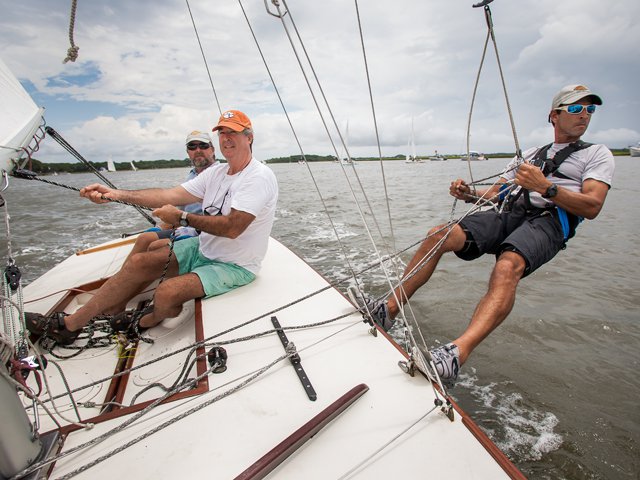
Hauled in tight
Flounder is usually the boat to beat in Sea Island One Design races, thanks to an experienced crew and use of the trapeze rigging for maximum speed. From left to right are captain Michael Miller, main trimmer Hank Hofford and jib trimmer Dan Valcoppi in the trapeze seat.
Photo by Mic Smith
2 of 6
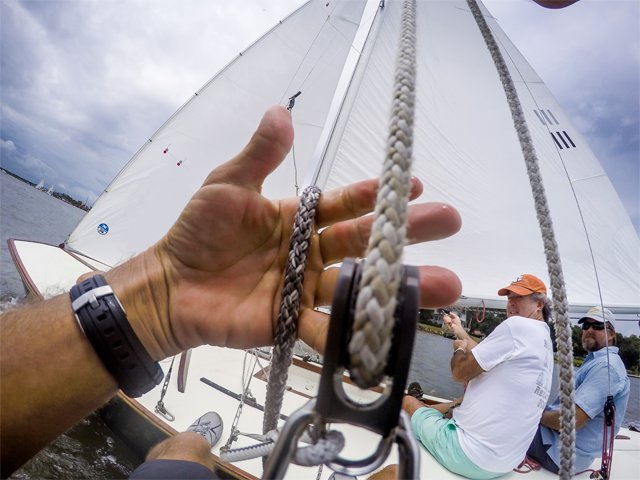
The view from out there
Suspended from the mast, the trapeze rigging allows the crew of Flounder to counterweight the boat, tighten the sails and eke out additional speed from the prevailing winds.
Photo by Mic Smith
3 of 6

Friendly competition
Stan LaRoche (right) talks shop with Michael Miller before the 2015 race. LaRoche, 63, began racing sailboats when he was 10 years old—and hasn’t missed a Rockville Regatta yet. While fierce competitors on the water, Sea Island One Design skippers are all good sports. “Michael is a really good sailor,” LaRoche says. “He likes beating me. I like beating him. At the end of the day, we have a rule: What goes on the boat stays on the boat, and when we come to shore, we’re all friends.”
Photo by Mic Smith
4 of 6
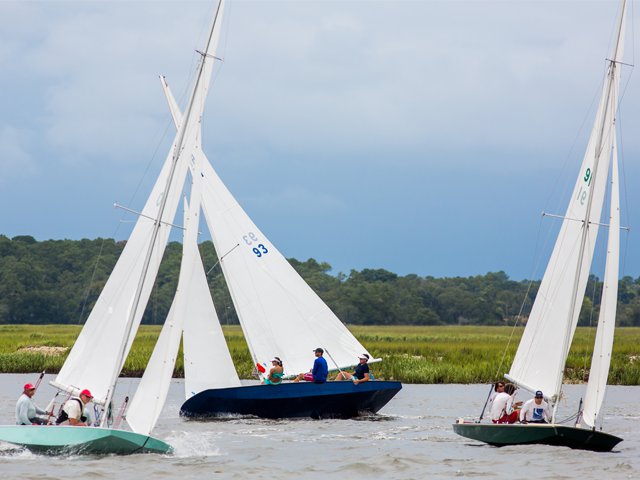
The race is on
Sea Island One Design boats in the 2015 Rockville Regatta maneuver through the narrows of Bohicket Creek off Wadmalaw Island.
Photo by Mic Smith
5 of 6
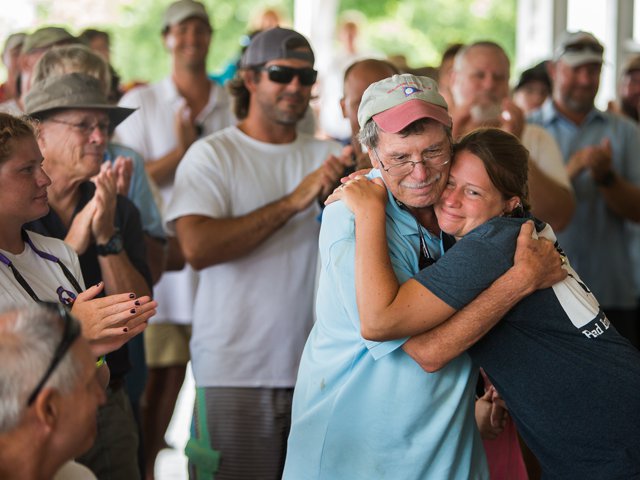
Spirit of Rockville
Volunteer Paul Andrews receives a hug from Jenny Gervais Gaffney after winning the Spirit of Rockville Award at the end of the 2015 regatta. Andrews has attended 70 of the popular races.
Photo by Mic Smith
6 of 6
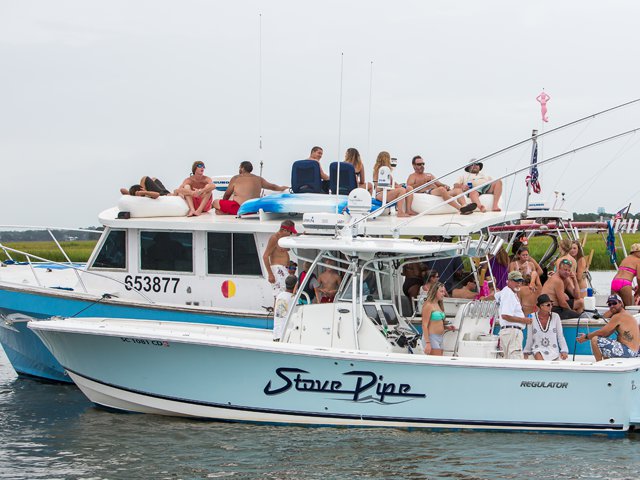
Cause for celebration
From yachts to rowboats, a fleet of spectator boats anchors in Bohicket Creek for a floating weekend party.
Photo by Mic Smith
At the last bend of Bohicket Creek, before its waters flow into the North Edisto River and finally spill into the Atlantic, a tiny village that treasures its past sits along the bluff edges of Wadmalaw Island.
Rockville emerged as a summer escape for Southern planters in the 1800s, and grand houses from the past two centuries line the creek under the cover of live oaks, leading to the Sea Island Yacht Club, which was last rebuilt as a public works project during the Depression.
Usually calm, the community erupts the first weekend in August with its annual regatta. Preceded by earlier Native American canoe races, the tradition officially dates back to 1890, when cousins Isaac Jenkins Mikell and John F. Sosnowski challenged one another to a sailing contest, according to Alicia Anderson Thompson’s book Rockville.
Mikell put up the Mermaid against Sosnowski’s Undine, which was named for a fabled water spirit that receives a soul when marrying a mortal. While the outcome has been forgotten, the legend endures, as does the name Undine, which has been given to a succession of sailboats, including one that still races.
The fifth Undine belongs to a special class of wooden sailboats created after World War II for yacht clubs around Charleston. The Sea Island One Design boats and their captains are the stars of the Rockville Regatta, and in recent years, the competition has ratcheted up, even as notorious partying by the spectator fleet has dialed down.
Sea Island One Design
While not exactly the same, members of the Sea Island One Design fleet are somewhat uniform, so their races test sailing skills over boat design, giving winners true bragging rights.
Of the nine Sea Island One Design boats racing today, four are considered original, built from 1947 to 1952 as the class was launched in the Lowcountry. That includes the Marcheta, which is owned and skippered by Stan LaRoche of Johns Island, typically a top race contender.
LaRoche’s grin pops out from his bushy, white mustache when he talks about racing. The 63-year-old skipper started sailing Sea Island One Design boats when he was 10, following his father’s lead, and hasn’t missed a Rockville Regatta since. Even when LaRoche was drafted into the Coast Guard out of high school and went to college in Minnesota, he found a way to return.
He began sailing the Marcheta after friends rebuilt it in 1980 and three years later “bought” it from them. “I gave them $25, and then they gave me $100 to fix it up,” laughs LaRoche. “They couldn’t find anyone else who wanted to sail it a lot.”
Preserving tradition
Hosted by yacht clubs along the Lowcountry coast, weekend regattas feature races with a range of sailboat classes and run through the summer, with the season culminating in Rockville. Racing and upkeep of the wooden Sea Island One Design boats, which require a three-person crew, can be a commitment, and the boats might have faded away, if it weren’t for the devotion of LaRoche and others like Rockville resident Van Smith.
Smith is credited with revitalizing the class when he commissioned a fifth Sea Island One Design boat, the Privateer, and christened it in 1989. The fleet eventually grew to nine boats, three of which are owned by Smith’s close friend Grayson Carter, including DogHouse, one of the originals. Carter’s attachment to the boats is sentimental.
“I have been coming to this yacht club, and to this regatta, since I was probably in diapers,” says Carter, whose parents met at a Sea Island Yacht Club dance. While he raced a few times as a teenager, these days the 55-year-old recruits younger men and women to sail his boats at regattas as he stands by in a motorboat, ready to help should any of the Sea Island One Design boats have an emergency.
For him, it’s not about owning the boats or about winning. “It’s about giving the younger generation an opportunity to sail and to be a part of the history and the tradition, to keep this thing going for all of us.”
Fighting for first
Others, like LaRoche, are more serious about the competition, which took an interesting turn in 2011, when Charleston builder Hank Hofford introduced Flounder, the youngest and possibly fastest Sea Island One Design boat. Hofford presented Flounder as a surprise to his son-in-law, Michael Miller, who happens to be a world-class sailor.
The 41-year-old Miller raced for College of Charleston during the 1990s and was on the U.S. Olympic sailing team from 1998 to 2008. When he skippers Flounder at regattas, the boat often takes first place, and with style. He typically has a crewmember harnessed in a trapeze that’s attached to the mast for added leverage, and his success has spurred other captains to use the trapeze more often, too.
“Michael is a really good sailor,” says LaRoche. “He likes beating me. I like beating him. At the end of the day, we have a rule: What goes on the boat stays on the boat, and when we come to shore, we’re all friends.”
Likewise, Miller respects his seasoned Sea Island One Design rivals. “They know the waters really well, and they know this race really well, and I learn something from them every time I come out.” He enjoys the tradition, and though he has sailed in races across the globe, he appreciates Rockville’s crowds. “This is the largest spectator fleet that I’ve ever encountered.”
An engaging spectacle
The fact that so many choose to watch the Rockville Regatta from the water has caused celebration and complaint. From yachts to rowboats, they cluster along the course for a floating weekend party. When the shrimping industry was still strong, trawlers would tie up so bands could perform on board.
Competitors previously had to navigate around the spectator fleet. Now those watching are cordoned off to allow for smoother and safer races, while sheriff’s deputies and South Carolina Department of Natural Resources officers control the merriment with extra manpower.
The scene is tamer on land, where generations watch the races from the lawns of Rockville’s homes and from the yacht club, which buzzes with activity from Friday to Sunday. The event is a labor of love for many club members, including Paul Andrews, whose volunteer efforts led him to win the Spirit of Rockville Award at the end of the 2015 regatta—his 70th, by the way.
If Andrews could choose, he’d like to savor his last sunset from the Sea Island Yacht Club porch. “Then, they can bring me back to the next Rockville and pour the ashes in the river,” he says. He has even talked about it with LaRoche. “Stanny said he would put some in a little vial and put me in the boat and take me sailing one more time.”
_____
Get There
Rockville Regatta
2016 weekend events run Aug. 5–7
Sea Island Yacht Club
2438 Sea Island Yacht Club Road, Wadmalaw Island
GPS: 32.597927, -80.196809
Latitude/Longitude: N32° 35.8756', W080° 11.8085'
_____
Sea Island One Design sailboats
Unique to coastal Charleston, Sea Island One Design sailboats were born in the late 1940s. The special racing class reflects the flat-bottomed working boats of the area’s past, ones that could smoothly navigate shoals while carrying heavy loads. The boats are also a throwback to a time when it was common to build with wood, which has since faded in popularity for sailboats in the South.
The fleet’s first four boats were built for local yacht clubs, based on sketches by Lowcountry resident Oliver Seabrook, with finishing touches by naval architect Henry Scheel from Mystic, Connecticut. The boats have slight variations but are very similar, with the same type of sails, mast, rudder and centerboard.
Five more Sea Island One Design boats were constructed in later years, closely following the originals, for a total of nine altogether. Individuals now own all but one, which belongs to the James Island Yacht Club. Collectively, the fleet calls Rockville’s Sea Island Yacht Club home.
General boat specifications
Length: 20 feet, 6 inches
Beam: 7 feet, 4 inches
Weight: around 950 pounds
The fleet
Sailboats in the fleet are listed here from oldest to youngest. The first four were built from 1947 to 1952. Sail numbers for the last five signify the years they debuted. Flounder launched in 2011.
SI59 Undine
SI60 Marcheta
SI66 Cygnet II
SI69 DogHouse
SI89 Privateer
SI91 Island Spirit
SI93 Bohicket II
SI94 Grey Ghost
SI111 Flounder
